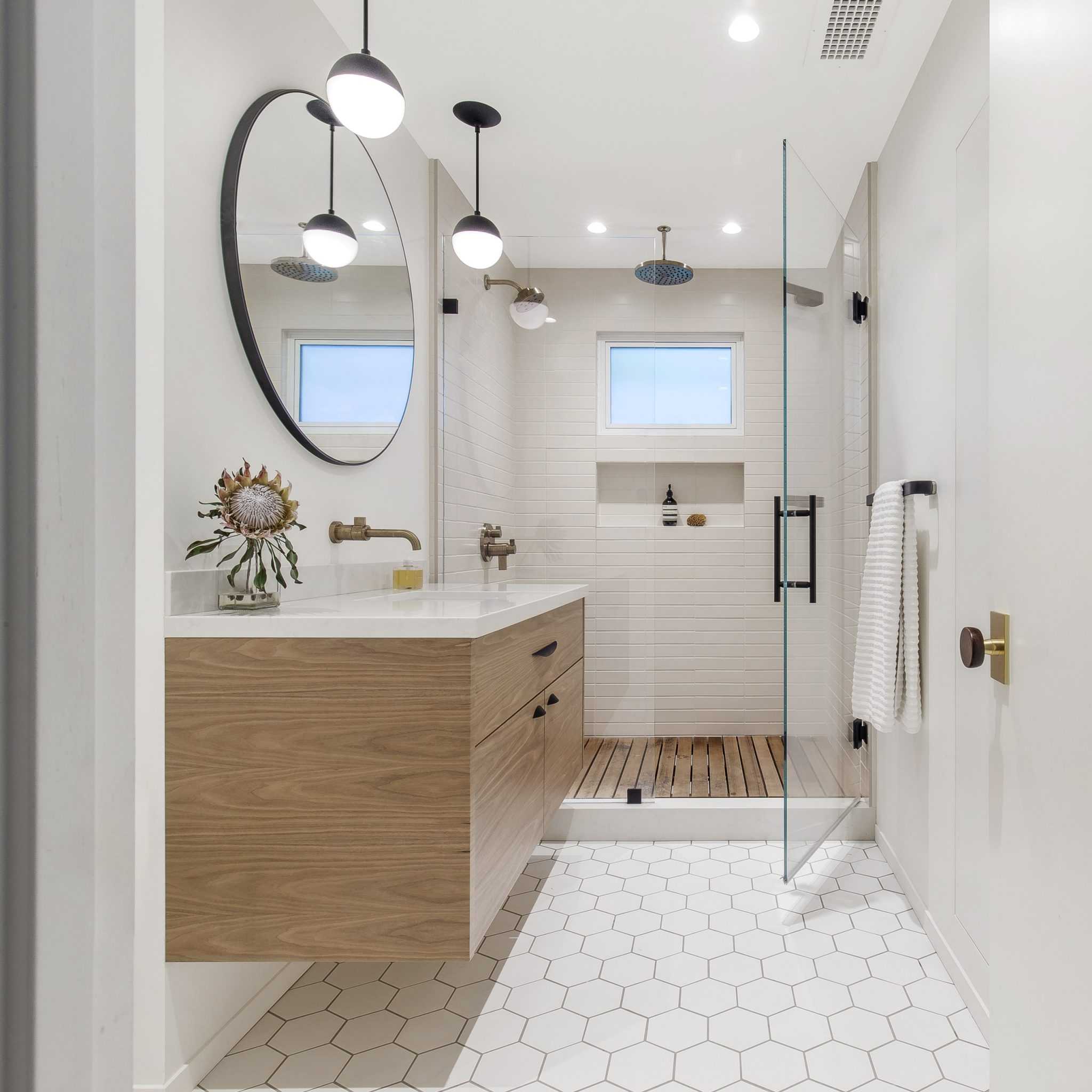Universal Design Principles for Aging-in-Place Bathrooms: Aging In Place Bathroom Design

Universal design principles are crucial for creating bathrooms that are accessible, safe, and comfortable for people of all ages and abilities, especially as we age. These principles focus on designing spaces that are usable by everyone, regardless of their physical or cognitive limitations.
Benefits of Universal Design Features for Aging in Place
Incorporating universal design features into a bathroom remodel can significantly enhance the quality of life for aging adults. These features make bathrooms more functional, safer, and easier to use, promoting independence and reducing the risk of falls or injuries.
- Increased Accessibility: Universal design features make bathrooms more accessible for individuals with mobility limitations, such as those using wheelchairs or walkers.
- Enhanced Safety: Features like grab bars and non-slip flooring reduce the risk of falls, which are a common concern for older adults.
- Improved Comfort: Accessible features, such as lever-style handles and adjustable showerheads, can make bathroom use more comfortable and less physically demanding.
- Increased Independence: By making bathrooms easier to use, universal design promotes independence and reduces the need for assistance with daily tasks.
- Long-Term Value: Universal design features are not only beneficial for aging adults but also increase the overall value and functionality of a home, making it more attractive to a wider range of buyers.
Examples of Universal Design Features in Bathrooms
Universal design features are essential for creating accessible and safe bathrooms for aging adults. Here are some examples of bathroom features that adhere to universal design principles:
- Grab Bars: Grab bars provide support and stability, reducing the risk of falls when getting in and out of the shower or tub. They should be installed in strategic locations, such as near the toilet, shower, and tub.
- Non-Slip Flooring: Non-slip flooring materials, such as textured tiles or rubber mats, can prevent slips and falls, especially in wet areas like showers and tubs.
- Lever-Style Handles: Lever-style handles on faucets and doors are easier to grip and operate than traditional knob handles, which can be difficult for people with arthritis or limited hand strength.
- Walk-In Showers: Walk-in showers eliminate the need to step over a high curb, making it easier and safer for people with mobility limitations to enter and exit the shower.
- Adjustable Showerheads: Adjustable showerheads allow users to adjust the water pressure and height to suit their individual needs and preferences.
- Raised Toilet Seats: Raised toilet seats make it easier for people with limited mobility to sit down and stand up from the toilet, reducing the risk of falls.
- Wider Doorways: Wider doorways allow for easier access for wheelchairs, walkers, and other mobility aids.
- Accessible Storage: Accessible storage solutions, such as pull-out shelves and drawers, make it easier to reach and retrieve items without bending or stretching.
- Adequate Lighting: Proper lighting is essential for visibility and safety in the bathroom. Consider using brighter light sources and installing nightlights for added safety.
Bathroom Safety Features for Seniors

Making a bathroom safe for seniors is essential for their well-being and independence. A few key safety features can significantly improve their comfort and reduce the risk of falls and injuries.
Walk-in Showers, Aging in place bathroom design
Walk-in showers are designed to eliminate the need to step over a high tub edge, which can be a significant safety hazard for seniors. They often feature a low threshold or no threshold at all, making it easy to enter and exit the shower.
- Easy Access: Walk-in showers allow seniors to enter and exit the shower without having to step over a high tub edge, reducing the risk of falls.
- Safety Features: Many walk-in showers include safety features like grab bars, non-slip floors, and adjustable showerheads to enhance comfort and safety.
- Accessibility: Walk-in showers are an excellent option for seniors with mobility issues, as they can easily maneuver within the shower area.
Raised Toilets
Raised toilets are another essential safety feature for seniors. They allow seniors to sit and stand up from the toilet with less strain, reducing the risk of falls and injuries.
- Ergonomic Design: Raised toilets are designed to make it easier for seniors to sit and stand up from the toilet, reducing strain on their joints and muscles.
- Increased Stability: The raised height provides seniors with a more stable platform, reducing the risk of falls during use.
- Comfort: Raised toilets can be more comfortable for seniors, especially those with back or knee problems.
Adequate Lighting
Proper lighting is crucial for bathroom safety, as it helps seniors see clearly and avoid tripping hazards.
- Brightness: Adequate lighting in the bathroom is essential for seniors to see clearly and avoid tripping hazards. Ensure the bathroom is well-lit, especially around the shower, toilet, and sink areas.
- Light Switches: Ensure light switches are easy to reach and operate, especially for seniors with limited mobility.
- Nightlights: Consider using nightlights in the bathroom to provide a soft, guiding light for seniors during nighttime trips to the bathroom.
Professional Assessment and Installation
It is crucial to seek professional advice when choosing and installing bathroom safety features for seniors. A professional can assess the bathroom’s layout and recommend the most appropriate safety features for the individual’s needs and abilities.
- Expert Advice: A professional can assess the bathroom layout and recommend the most appropriate safety features for the individual’s needs and abilities.
- Safe Installation: Professional installation ensures that the safety features are properly installed and meet safety standards.
- Peace of Mind: Having safety features professionally installed provides peace of mind and ensures that the bathroom is safe and comfortable for seniors.
Creating a Functional and Stylish Aging-in-Place Bathroom

Aging in place doesn’t mean sacrificing style. You can create a bathroom that’s both accessible and visually appealing, a space that reflects your personality and makes you feel comfortable. This section explores how to design a bathroom that prioritizes functionality while incorporating aesthetic elements.
Designing a Bathroom Layout
A well-designed layout is key for an accessible and functional bathroom. Here are some key considerations:
- Wide doorways and hallways: Ensure sufficient space for wheelchairs or walkers to maneuver easily.
- Accessible shower: Consider a walk-in shower with a non-slip floor and grab bars for added safety and support.
- Accessible toilet: Choose a toilet with a raised seat height and grab bars for easier use.
- Storage solutions: Incorporate accessible storage solutions, such as pull-out drawers and shelves, to make it easier to reach items.
Bathroom Fixtures for Aging in Place
The right fixtures can make a significant difference in bathroom accessibility and functionality. This table showcases various bathroom fixtures and their benefits for aging in place:
| Fixture | Benefits | Color Options | Material Choices | Accessibility Features |
|---|---|---|---|---|
| Toilet | Raised seat height, elongated bowl, grab bars | White, ivory, beige, gray | Ceramic, porcelain, acrylic | Raised seat height, grab bars, elongated bowl |
| Shower | Walk-in design, non-slip floor, grab bars | White, gray, beige, black | Ceramic tile, acrylic, fiberglass | Walk-in design, non-slip floor, grab bars, adjustable showerheads |
| Sink | Undermount sink, easy-to-clean surface, accessible faucet | White, gray, black, stainless steel | Ceramic, porcelain, stainless steel | Undermount design, accessible faucet with lever handles, integrated soap dispenser |
| Bathtub | Walk-in design, non-slip floor, grab bars | White, gray, beige, black | Acrylic, fiberglass, cast iron | Walk-in design, non-slip floor, grab bars, adjustable showerheads |
Bathroom Design Trends for Aging Adults
Many design trends cater to the needs and preferences of aging adults, creating a space that is both stylish and functional.
- Incorporating natural light: Large windows or skylights can brighten the bathroom and create a more inviting atmosphere.
- Using contrasting colors: High-contrast colors can help with visibility and make it easier to navigate the bathroom, especially for individuals with low vision.
- Minimizing clutter: A clutter-free bathroom is easier to maintain and provides a sense of calm and tranquility.
- Using non-slip surfaces: Non-slip flooring and shower surfaces are essential for safety, especially for older adults who may be at risk of falls.
- Creating a spa-like atmosphere: Incorporate soothing colors, soft lighting, and natural materials to create a relaxing and rejuvenating bathroom experience.
